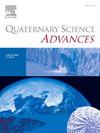The Quaternary La Garrotxa volcanic field (NE of Iberia): A geochronological approach
IF 2.2
Q2 GEOGRAPHY, PHYSICAL
引用次数: 0
Abstract
Monogenetic volcanic fields exhibit extended periods of magmatic activity, often spanning several million to tens of millions of years. Understanding the evolution of this activity is challenging due to incomplete geological records and limited geochronological data. However, the relative volcanic stratigraphy and morphometric analysis of volcanic landforms enable the identification of temporal patterns in volcanic activity. These patterns often reveal clusters of eruptions interspersed with periods of relative inactivity, reflecting the tectonic evolution of the region, which influences magma generation and ascent.
Quantifying this temporal evolution is crucial for Quaternary monogenetic fields, as their activity may still be ongoing, posing potential risks. This is exemplified by the La Garrotxa volcanic field in the Catalan Volcanic Zone, part of the European Rift System, active from the mid-Pleistocene to the early Holocene. In this study, we present 15 new Ar-Ar ages, along with a comprehensive field review, to accurately establish the recent temporal evolution of this volcanic field, refining previous stratigraphies based solely on field relations and morphometric analysis. These new ages indicate that volcanic activity in the La Garrotxa Volcanic Field is more recent and frequent than previously believed, with significant implications for volcanic hazard assessment.
第四纪La Garrotxa火山场(伊比利亚东北部):地质年代学研究
单成因的火山场表现出延长的岩浆活动期,通常跨越几百万到数千万年。由于不完整的地质记录和有限的地质年代学数据,了解这种活动的演变是具有挑战性的。然而,相对火山地层学和火山地貌的形态计量学分析使得火山活动的时间模式得以识别。这些模式往往揭示了火山喷发群穿插在相对不活跃的时期,反映了该地区的构造演化,这影响了岩浆的产生和上升。量化这种时间演变对第四纪单成因场至关重要,因为它们的活动可能仍在进行中,构成潜在的风险。作为欧洲裂谷系的一部分,加泰罗尼亚火山区的La Garrotxa火山场活跃于中更新世至全新世早期。在这项研究中,我们提出了15个新的Ar-Ar年龄,并进行了全面的现场回顾,以准确地建立该火山场的近期时间演化,完善了以前仅基于场关系和形态计量学分析的地层。这些新时代表明,La Garrotxa火山田的火山活动比以前认为的更近、更频繁,这对火山危险性评估具有重要意义。
本文章由计算机程序翻译,如有差异,请以英文原文为准。
求助全文
约1分钟内获得全文
求助全文
来源期刊

Quaternary Science Advances
Earth and Planetary Sciences-Earth-Surface Processes
CiteScore
4.00
自引率
13.30%
发文量
16
审稿时长
61 days
 求助内容:
求助内容: 应助结果提醒方式:
应助结果提醒方式:


